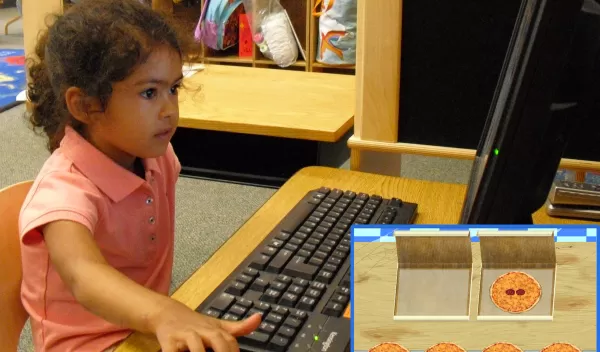
Viewing the World Through a "Mathematical Lens" Can Help Young Children Learn Math
Teaching children mathematics at a young age may be as simple as helping them see how math is all around them.
"Children as young as three to five years of age have the potential to learn mathematics that is surprisingly complex and sophisticated," said Doug Clements, a State University of New York Distinguished Professor at the University at Buffalo. "Further, they are motivated to learn mathematics. Indeed, almost half of the time they engage in free play, they use mathematical ideas, although usually implicitly."
Helping children identify and connect the mathematics ideas that they use in free play and other daily activities is crucial to children gaining a strong math foundation at an early age.
However, not all children have the opportunity to develop these ideas and skills.
"Unfortunately, this potential is left unrealized for many children throughout the world--especially for children from low-income communities," said Clements. "They have the same implicit understanding of mathematics as their higher-income peers but have not had the opportunities to think and talk about mathematics explicitly--that is, to learn the language of mathematics."
With funding from the National Science Foundation (NSF), Clements and Julie Sarama, professor and chair of the Department of Learning and Instruction at the University at Buffalo, and their colleagues develop intervention curriculums and tools that help children better understand the "language of mathematics" and learn early math skills.
Finding math in everyday activities
What does understanding the language of mathematics entail? Clements explains that it is a way of understanding the world through a "mathematical lens."
"It is important that all children learn to mathematize their informal experiences by understanding and talking about them," said Clements. "If they do not, lower-income children lose the connection between their informal knowledge and later school mathematics--and the gap between them and their more advantaged peers widens, year after year."
"Mathematization emphasizes representing and elaborating mathematically--creating models of everyday situations with mathematical objects, such as numbers and shapes; mathematical actions, such as counting or transforming shapes; and their structural relationships--and using those models to solve problems so derived," said Clements. "Mathematizing often involves representing relationships in the situation so these relationships can be quantified. We love the mathematics in puzzles, blocks and songs. However, if it's 'just play with blocks,' too often little mathematics is learned."
Clements explained that understanding math is something that everyone can learn and excel in.
"We see no signs, in our research or the research in general, of 'natural' inclinations," said Clements. "Experience and opportunity to learn--these are the factors that appear to influence children's motivation as well as achievement in most areas."
Clements, Samara and their colleagues developed Building Blocks, which is an intervention designed to help children identify and learn basic mathematical concepts through daily activities.
Building Blocks
The goal of Building Blocks is to help children find the mathematics in, and develop the mathematics from, their everyday activities--whether it's through art, stories, puzzles or games. Comprised of print materials, software and more, Building Blocks seeks to help children learn number concepts, such as counting, basic arithmetic and spatial and geometric concepts and processes.
Building Blocks led to large increases in mathematical knowledge of young children in several small studies. To evaluate Building Blocks on a larger scale, Clements and his team conducted a study of 36 classrooms to understand the impact of these interventions. It was found that Building Blocks increased scores on a mathematics achievement test and increased the quantity and quality of the mathematics environment and teaching in all classrooms, from low and middle income groups.
An example of Building Blocks involves children using the Building Blocks software to complete puzzles by putting together different 2-D shapes on the computer screen. Children can also make their own puzzles using the shapes. The goal of this activity is to help children see shapes as composed of various parts, a foundational concept of early mathematics. Children can eventually apply this idea to other part-whole relationships, like counting units that make up a set arrangement, or in language arts, combining letters to create words.
TRIAD
Even larger-scale studies have shown that Building Blocks has been especially beneficial for pre-schoolers from low-income communities. Clements and Sarama are further investigating Building Blocks through TRIAD (Technology-enhanced, Research-based, Instruction, Assessment, and professional Development), which is a framework to develop Building Blocks on a larger scale and provide Building Blocks pre-kindergarten mathematics curriculum. It is designed to be a collaborative project among administrators, teachers and families, and also provides on-site classroom support, professional development for teachers, coaches and mentors, and assessments for research collaborators.
"We are now following the largest cohort of children into their intermediate grades," said Clements. "With NSF funding, we are developing a new interdisciplinary version of Building Blocks with colleagues. We do hope these interventions catch on in all preschools."


